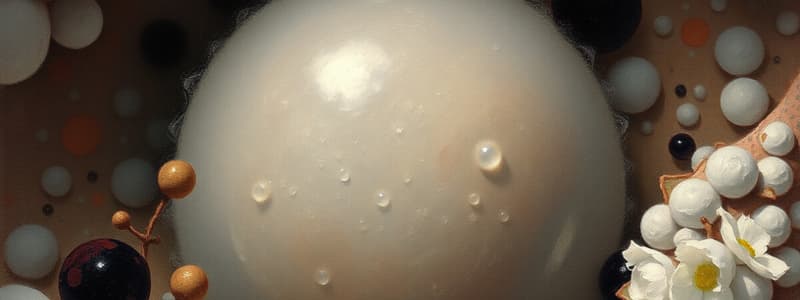Podcast
Questions and Answers
What is the relationship between cell size and efficiency of cellular processes?
What is the relationship between cell size and efficiency of cellular processes?
- Smaller surface area improves the efficiency of cell processes.
- Smaller cells have a larger surface area relative to their volume. (correct)
- Cell efficiency is not affected by cell size.
- Larger cells are always more efficient due to increased volume.
Which factor does NOT influence a cell's shape?
Which factor does NOT influence a cell's shape?
- Cell function
- Environmental conditions (correct)
- Internal structures
- Genetic makeup
What does the internal organization of a cell indicate?
What does the internal organization of a cell indicate?
- It is irrelevant to the cell's function.
- It provides clues about the cell's specific function. (correct)
- It requires a certain cell shape to be effective.
- It varies and is not related to specific functions.
Which of the following statements about surface area to volume ratios is correct?
Which of the following statements about surface area to volume ratios is correct?
Which surface area and volume pair correctly illustrates the relationship of increasing size?
Which surface area and volume pair correctly illustrates the relationship of increasing size?
What component of a light microscope allows light to pass from the objective to the eyepiece?
What component of a light microscope allows light to pass from the objective to the eyepiece?
Which part of the microscope regulates the amount of light reaching the specimen?
Which part of the microscope regulates the amount of light reaching the specimen?
Which part is primarily responsible for holding the slide in place during an examination?
Which part is primarily responsible for holding the slide in place during an examination?
What is the function of the condenser in a light microscope?
What is the function of the condenser in a light microscope?
Which component of the microscope allows the selection of different magnifying lenses?
Which component of the microscope allows the selection of different magnifying lenses?
What is the primary purpose of the arm in a microscope?
What is the primary purpose of the arm in a microscope?
Study Notes
Cell Size
- Majority of cells are microscopic, allowing for efficient nutrient uptake and waste removal.
- Smaller surface area enhances efficiency and effectiveness in cellular processes.
- The relationship between surface area and volume is critical for cellular function.
Surface Area and Volume Data
- Surface Area (cm²) examples: 24, 96, 216, 384
- Corresponding Volume (cm³) examples: 8, 64, 216, 512
- Surface Area to Volume Ratios:
- For 24 cm²: Ratio is 3
- For 96 cm²: Ratio is 1.5
- For 216 cm²: Ratio is 1
- For 384 cm²: Ratio is 0.75
Cell Shape
- A cell’s shape is directly linked to its specific function; different functions require different structures.
Internal Organization
- Variation in internal organization across different cell types reflects their distinct roles.
- Structural characteristics are crucial in determining a cell's possible functions and efficiency.
Parts of a Light Microscope
-
Mechanical Parts: Fundamental components responsible for supporting and maneuvering the microscope.
-
Illuminating Parts: Elements that provide light for viewing specimens.
-
Magnifying Parts: Components involved in enlarging the image of the specimen.
-
Body Tube: Hollow tube facilitating light passage from the objective lens to the eyepiece, integral for image clarity.
-
Revolving Nosepiece: Holds multiple objective lenses and allows rotation to switch between them; must be clicked into place for accurate viewing.
-
Arm: Connects the base and body tube, serves as a handle for safe transport of the microscope.
-
Stage: Flat platform for placing slides; includes an opening at the center to allow light to illuminate the specimen from below.
-
Stage Clip: Secures the slide in place on the stage, preventing movement during observation.
-
Base: Provides structural support and stability to the microscope; where illuminators are mounted.
-
Inclination Joint: A hinge connecting the arm to the pillar, permitting angular adjustment for better viewing angles.
-
Mirror: Reflects ambient light towards the stage; features a planar side for normal light and a concave side for enhanced light concentration.
-
Condenser: Gathers and focuses light onto the specimen, improving visibility and detail.
-
Iris Diaphragm: Controls the intensity of light that reaches the specimen, allowing for clearer observation based on the specimen type.
-
Eyepiece (Ocular Lens): The lens through which the observer views the specimen, essential for magnification.
-
Objectives: Primary optical elements that magnify the specimen; various lenses provide different levels of magnification for diverse observational needs.
Studying That Suits You
Use AI to generate personalized quizzes and flashcards to suit your learning preferences.
Description
Explore the vital relationship between cell size, surface area, and volume. This quiz examines how a cell's shape and internal structure contribute to its specific functionality and efficiency across various types. Test your understanding of these fundamental concepts in cellular biology.



